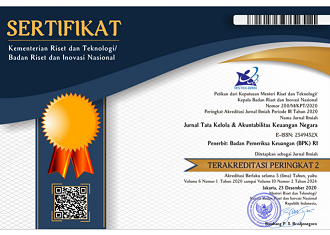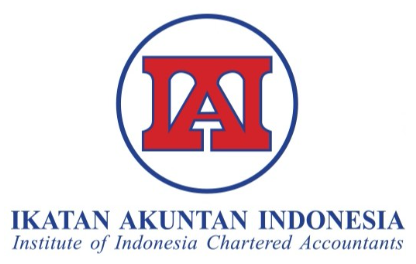A REVIEW ON THE USE OF REGRESSION ANALYSIS IN STUDIES OF AUDIT QUALITY
DOI:
https://doi.org/10.28986/jtaken.v1i1.22Keywords:
Audit quality, regression analysis, Kualitas audit, analisis regresiAbstract
This study aimed to review how regression analysis has been used in studies of abstract phenomena, such as audit quality, and important concept in the auditing practice (Schroeder et al., 1986), yet is not well defined. The articles reviewed were the research articles that include audit quality as a research variable, either as dependent or independent variables. The articles were purposefully selected to represent a balanced combination between audit specific and more general accounting journals and between Anglo Saxon and Anglo American journals. The articles were published between 1983-2011 and from the A/A class journal based on ERA 2010s classifications. The study found that most of the articles reviewed used multiple regression analyses and treated audit quality as a dependent variable and measured it by using a proxy. This study also highlights the size of the data sample used and the lack of discussions about the assumptions of the statistical analysis used in most of the articles reviewed. This study concluded that the effectiveness and validity of multiple regressions do not only depend on its application by the researchers but also on how the researchers communicate their findings to the audience.
ABSTRAK
Kajian ini bertujuan untuk mereviu bagaimana analisa regresi digunakan dalam suatu fenomena abstrak seperti kualitas audit, suatu konsep yang penting dalam praktik audit (Schroeder et al., 1986) namun belum terdefinisi dengan jelas. Artikel yang direviu dalam kajian ini adalah artikel penelitian yang memasukkan kualitas audit sebagai variabel penelitian, baik sebagai variabel independen maupun dependen. Artikel-artikel tersebut dipilih dengan cara purposif sampling untuk mendapatkan keterwakilan yang seimbang antara artikel jurnal khusus audit dan akuntansi secara umum, serta mewakili jurnal Anglo Saxon dan Anglo American. Artikel yang direviu diterbitkan pada periode 1983-2011 oleh jurnal yang masuk dalam kategori A/A berdasarkan klasifikasi ERA pada tahun 2010. Kajian ini menemukan bahwa sebagian besar artikel-artikel tersebut menggunakan analisa regresi berganda dan menjadikan kualitas audit sebagai variabel dependen serta mengukurnya menggunakan proksi. Kajian ini juga menyoroti ukuran data sampel yang digunakan dan kurangnya pembahasan mengenai asumsi yang digunakan dalam analisa statistik. Kajian ini menyimpulkan bahwa efektivitas dan validitas penggunaan analisa regresi berganda dalam penelitian tidak hanya bergantung pada kemampuan peneliti untuk menggunakannya, namun juga pada kemampuan peneliti untuk mengkomunikasikan hasil penelitiannya kepada pembaca.
References
Allison, P. D. (1999). Multiple Regression: A Primer. Thousand Oaks, CA: Pine Forge Press.
Behn, B. K., Choi, J., & Rang, T. (2008). Audit Quality and Properties of Analyst Earnings Forecasts. The Accounting Review, 83(2), 327-349.
Berry, W. D. (1993). Understanding Regression Assumptions. Sage University Paper Series on Quantitative Applications in the Social Science, Newbury Park, CA: Sage.
Bohrnstedt, G. W., & Carter, T. M. (1971). Robustness in Regression Analysis. Sociological Methodology, 3, 118-146.
Francis, J. R. (2011). A Framework for Understanding and Researching Audit Quality. Auditing: A Journal of Practice & Theory, 30(2), 125-152.
Frost, P. A. (1979). Proxy variables and specification bias. Review of Economic Statistics, 61, 323-325.
Guay, W., Kothari, S. P. & Watts, R. (1996). A market-based evaluation of discretionary-accrual models. Journal of Accounting Research, 34 (Supplement), 83-115.
Hair, J. F. Jr., Black, W. C., Babin, B. J., Anderson, R. E., & Tatham, R. L. (2006). Multivariate Data Analysis, 6th Edition. Upper Saddle River, NJ: Pearson Prentice Hall.
Keith, T. Z. (2006). Multiple Regression and Beyond. Boston, MA: Pearson Education Inc.
Krishnan, G. V. (2003). Audit Quality and the Pricing of Discretionary Accruals. Auditing: A Journal of Practice & Theory, 22(1), 109-126.
Kutner, M. H., Natchtsheim, C. J., & Neter, J. (2004). Applied Linear Regression Models, 4th Edition. New York, NY: McGraw-Hill Irwin.
Lawrence, A., Minutti-Meza, M., & Zhang, P. (2011). Can Big 4 versus Non-Big 4 Differences in Audit-Quality Proxies Be Attributed to Client Characteristics? The Accounting Review, 86(1), 259- 286.
Maddala, G. S. (1977). Econometrics. New York: McGraw-Hill.
McCallum, B. T. (1972). Relative asymptotic bias from errors of omission and measurement. Econometrica, 40, 757-758.
Schroeder, M. S., Solomon, I., & Vickery, D. (1986). Audit Quality: The Perceptions of Audit-Committee Chairpersons and Audit Partners. Auditing: A Journal of Practice & Theory, Spring, 86-94.
Trenkler, G. & Stahlecker, P. (1996). Dropping variables versus the use of proxy variables in linear regression. Journal of Statistical Planning and Inference, 50, 65-75.
Upton, G. & Cook, I. (2002). A dictionary of statistics. New York: Oxford University Press.
Western, B. (1995). Concepts and Suggestions for Robust Regression Analysis. American Journal of Political Science. 39(3), 786-817.
Wickens, M. R. (1972). A note on the use of proxy variables. Econometrica, 40, 759-761.
Downloads
Submitted
Accepted
Published
How to Cite
Issue
Section
License

Jurnal Tata Kelola dan Akuntabilitas Keuangan Negara is licensed under
a Creative Commons Attribution-ShareAlike 4.0 International License




















